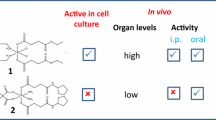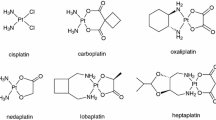Abstract
The preclinical toxicology and tissue platinum distribution of a series of six orally given antitumour platinum complexes [ammine/amine platinum(IV) dicarboxylates] with structural variations of their alicyclic amine (c-C5, c-C6 or c-C7), axial dicarboxylate (CH3, C3H7 or NHC2H5) or leaving substituents (Cl2 or OCOOCO) was studied in the mouse. Platinum tissue levels measured at 48 h after a single oral dose at 0.5 of the MTD were highest in the liver (6.0–19 μm/g) and second highest in the kidney (2.8–12 μg/g), and these levels were up to 5 times higher than those reported with equi-toxic doses of i.v. cisplatin and i.v. carboplatin. Platinum levels in the lung, heart, spleen, skin, skeletal muscle and brain were all<-3.1 μg/g at this dose level. Liver platinum levels measured at 2 h, 2 days, 6 days and 10 days after a single oral dose at the MTD ranged widely (from 15 to 109 μg platinum/g), were related to the number of carbon atoms in the axial dicarboxylate and alicyclic amine groups (r=0.9389) and showed a diversity of time-course profiles. Elevations of plasma ALT activity were recorded with single oral doses of JM225 and JM256 at the MTD. Accumulation of platinum in the liver with repeated oral dosing weekly for 4 consecutive weeks at 0.5 of the MTD occurred with JM269 (3.3-fold increase,P<0.05) and JM 225 (2.4-fold increase,P<0.05), and elevated plasma ALT activity (44±33 IU/I) was recorded with repeated oral doses of JM269. JM216 was selected from this series of analogues for further study on the basis of the elevated plasma ALT activity (JM225, JM256 and JM269), liver platinum accumulation (JM269 and JM225), poor activity against human ovarian carcinoma xenografts (JM291) or severe emetogenesis (JM221) of other examples. Following a single oral dose of JM216 at the MTD, transient reductions in the WBC (nadir, 1.6×109/ 1,2 days, 74% reduction), platelet count (nadir, 613×109/l, 10 days, 33% reduction) and bone marrow cellularity (nadir, 0.5×107 nucleated cells/femur, 4 days, 75% reduction) were found, and these had recovered by 21 days after treatment. Jejunal mucosal disaccharidase activity following single MTDs indicated that small-intestinal mucosal damage was less severe for oral JM216 (nadir maltase activity, 68%±16% of control, NS) than for i.v. cisplatin (nadir maltase activity, 35%±6.0% of control,P<0.01) and i.v. carboplatin (nadir maltase activity, 38%±6.4% of control,P<0.01). In conclusion, the liver is the major tissue platinum deport for orally delivered ammine/amine platinum(IV) dicarboxylates and is a site of toxicity for examples of this class. Oral JM216 causes dose-limiting leucopenia but produces less gastrointestinal toxicity than either i.v. cisplatin or i.v. carboplatin at the MTD in the mouse.
Similar content being viewed by others
Abbreviations
- ALP:
-
alkaline phosphatase
- ALT:
-
alanine aminotransferase; carboplatin,cis-diamminecyclobutanedicarboxylatoplatinum(II); cisplatin,cis-diamminedichloroplatinum(II)
- EDTA:
-
ethylenediaminetetraacetic acid
- MTD:
-
maximally tolerable dose
- NS:
-
not significant
References
Siddik ZH, Jones MR, Boxall FE, Harrap KR (1988) Comparative distribution and excretion of carboplatin and cisplatin in mice. Cancer Chemother Pharmacol 21:19–24
Kelland LR, Jones M, Gwynne JJ, Valenti M, Murrer BA, Barnard CFJ, Vollano JF, Giandomenico CM, Abrams MJ, Harrap KR (1993) Antitumour activity of orally administered ammine/amine platinum(IV) dicarboxylate complexes against a panel of human ovarian carcinoma xenografts. Int J Oncol 2:1043–1048
Harrap KR, Murrer BA, Giandomenico C, Morgan SE, Kelland LR, Jones M, Goddard PM, Schurig J (1991) Ammine/amine platinum IV platinum dicarboxylates: a novel class of complexes which circumvent intrinsic cisplatin resistance. In: Howell SB (ed) Platinum and other metal coordination compounds in cancer chemotherapy. Plenum, New York, pp 391–399
Kelland LR, Murrer BA, Abel G, Giandmenico CM, Mistry P, Harrap KR (1992) Ammine/amine platinum(IV) dicarboxylate complexes: a novel class of platinum complex exhibiting selective cytotoxicity to intrinsically resistant human ovarian carcinoma cells. Cancer Res 52:822–828
Kelland LR, Abel G, McKeage MJ, Jones M, Goddard PM, Valenti M, Murrer BA, Harrap KR (1993) Preclinical antitumour evaluation of bis-acetato-amine-dichloro-cyclohexylamine platinum(IV): an orally active platinum drug. Cancer Res 53: 2581–2586
Reed E, Kohn KW (1990) Platinum analogues. In: Chabner BA, Collins JM (eds) Cancer chemotherapy: principles and practice. J. B. Lippincott, Philadelphia, pp 465–490
Siddik ZH, Boxall FE, Harrap KR (1987) Haematological toxicity of carboplatin in rats. Br J Cancer 55:375–379
Allan S, Smyth JF, Hay FG, Leonard RCF, Wolf CR (1986) Protective effect of sodium-2-mercaptoethanesulfonate on the gastrointestinal toxicity and lethality ofcis-diamminedichloroplatinum. Cancer Res 46:3569–3573
Siddik ZH, Dible SE, Boxall FE, Harrap KR (1986) Renal pharmacokinetics and toxicity of cisplatin and carboplatin in animals. In: McBrien DCH, Slater TF (eds) Biochemical mechanisms of platinum antitumour drugs. IRL Press, Oxford, pp 171–198
Siddik ZH, Boxall FE, Harrap KR (1987) Flameless atomic absorption spectrophotometric determination of platinum in tissues solubilized in hyamine hydroxide. Anal Biochem 163:21–26
Dahlqvist A (1968) Assay of intestinal disaccharidases. Anal Biochem 22:99–107
Lowry OH, Rosenbrough NH, Farr AL, Randall RJ (1951) Protein measurement with the Folin reagent. J Biol Chem 193:265
McKeage MJ, Morgan SE, Boxall FE, Murrer BA, Hard GC, Harrap KR (1993) Lack of nephrotoxicity of oral ammine/amine platinum(IV) dicarboxylate complexes in rodents. Br J Cancer 67: 996–1000
Aldhous P (1991) Tide turns against LD50. Nature 353:489
Balls M (1991) Why modification of the LD50 test will not be enough. Lab Anim 25:198–206
Guarino AM, Rozencweig M, Kline I, Penta JS, Venditti JM, Lloyd HH, Holzworth DA, Muggia FM (1979) Adequacies and inadequacies of assessing murine toxicity data with antineoplastic agents. Cancer Res 39:2204–2210
Author information
Authors and Affiliations
Additional information
Institute of Oncology, The Prince of Wales Hospital, High Street, Randwick, Sydney NSW 2031, Australia
Rights and permissions
About this article
Cite this article
McKeage, M.J., Morgan, S.E., Boxall, F.E. et al. Preclinical toxicology and tissue platinum distribution of novel oral antitumour platinum complexes: ammine/amine platinum(IV) dicarboxylates. Cancer Chemother. Pharmacol. 33, 497–503 (1994). https://doi.org/10.1007/BF00686508
Received:
Accepted:
Issue Date:
DOI: https://doi.org/10.1007/BF00686508




